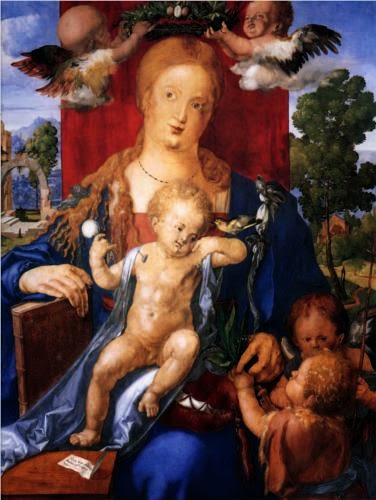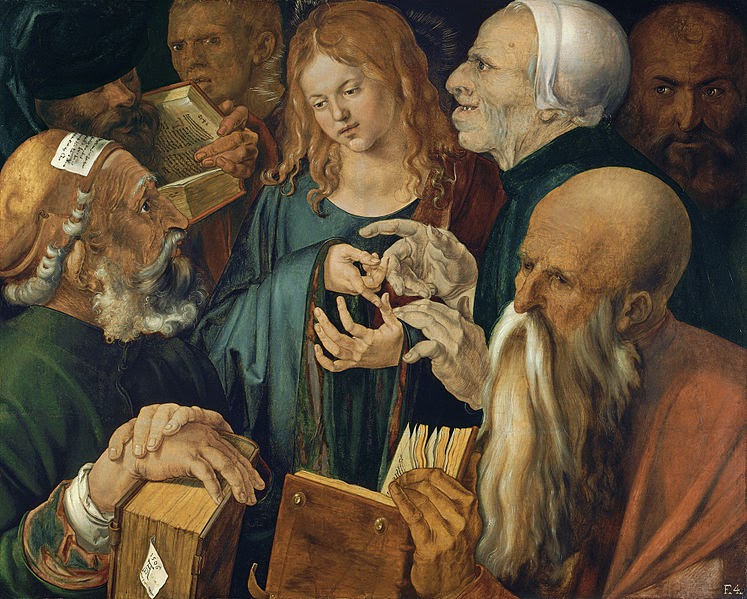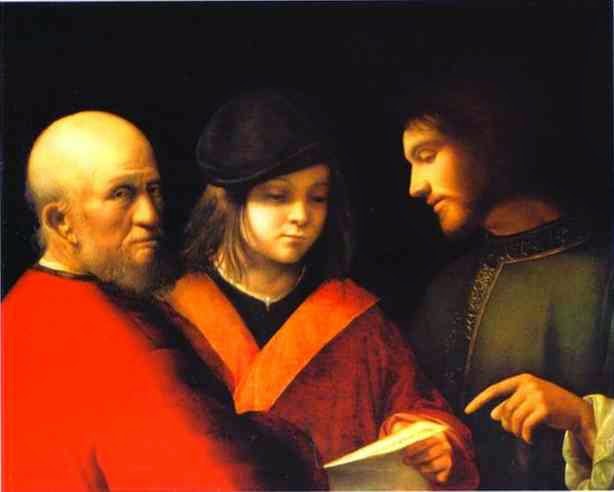Albrecht Durer in Venice
Albrecht Durer traveled to Venice in the latter half of 1505 and stayed until early in 1507. It seems that he had planned this journey for a while but apparently an outbreak of plague in Nuremburg hastened his departure. Erwin Panofsky devoted a whole chapter to the Venetian sojourn in his magisterial study, The Life and Art of Albrecht Durer. Panofsky entitled the chapter, ‘The Second Trip to Italy and the Culmination of Painting, 1505-1510/11.’

Panofsky points out that Durer had achieved a high degree of fame even before this visit to Venice. In Panofsky’s words,
The young beginner who had visited Venice eleven years before was now a world-renowned master whose inventions were copied and imitated everywhere. Also, he was no longer poor….Thus he did not walk about the city as an unknown and insignificant tourist but plunged into its colorful and stimulating life as a distinguished guest. He became acquainted with ‘intelligent scholars, good lute-players, flutists, connoisseurs of painting and many noble minds’ who honored and befriended him. [107-8]
Despite his mastery in wood-cut and engraving, Durer turned exclusively to oil painting while in Venice. Panofsky indicates that Venice and its painters had a great impact on the German master. From his correspondence we know that Durer regarded the aged Giovanni Bellini as still the greatest of painters, but in a letter dated February 7, 1506, Durer mentioned that he had also found “many painters much superior to Jacopo de’ Barbari,” an artist already well-known to Durer before the Italian trip.
Panofsky indicates that Durer turned to painting to show that he could work with color as well as any Venetian, but also because of the desires of his patrons in Venice. Almost immediately on his arrival Durer was welcomed by the prosperous German merchant community. It would appear that connections in Nuremberg and Augsburg had paved the way for him and even arranged a lucrative commission to paint an altarpiece for S. Bartolommeo, the German church in Venice. In a letter to a friend about the altarpiece, usually called the “Feast of the Rose Garlands,” Durer claimed that the commission was an effective way to “silence those who said I was good as an engraver but did not know how to handle the colors in painting.” [109-110]

On the completion of the Feast of the Rose Gardens Durer bragged, “I herewith announce that there is no better image of the Virgin in the country.” This claim might be exaggerated but the painting did gain much acclaim.
Old Giovanni Bellini…visited his studio and expressed the wish to acquire one of his paintings…When the “Feast of the Rose Garlands” was completed it was admired by the whole Venetian aristocracy, including the Doge and the Patriarch, and finally even by Durer’s colleagues….” [109]
Panofsky agrees with this contemporary evaluation despite the very poor condition of the painting today. “In one propitious moment he succeeded in synthesizing the force and accuracy of his design with the rich glow of Venetian color.” Panofsky acknowledges Durer’s debt to Bellini
The balanced grandeur of this composition would not have been attainable to Durer without the study and complete understanding of the style of Giovanni Bellini whom he so frankly admired… (112)
The painting was inspired by the increasingly popular devotion to the rosary, especially among the Dominican friars, whose founder was considered to have been the creator of the devotion. The rose garlands in the painting actually represent the decades of the rosary, and in Panofsky’s opinion the painting should actually be titled, “the Brotherhood of the Rosary.”
While working on the altarpiece for S. Bartolommeo, Durer also completed two smaller paintings of sacred subjects. The first was the so-called Madonna of the Siskin, now in the Staatliche Museum in Berlin. The second was a version of Christ Among the Doctors that is now in the Thyssen Bornemisza collection in Madrid.

The “Madonna of the Siskin” derives its popular name from the bird on the arm of the infant Jesus. However, it is actually a representation of the meeting of the young John the Baptist with the Holy Family on their return from the sojourn in Egypt. Panofsky notes that the young Baptist is the most significant iconographical feature in the painting.
The inclusion of this figure…was an utter novelty in Northern art which…knew only the triad of the Holy Family and the complete circle of the Holy Kinship, but not the “Virgin with the Infant Jesus and the Little St. John.” This theme was Central Italian rather than Venetian, but that compositions not unlike Durer’s…existed in Venice and the “Terra Firma” is demonstrated… [113]
In Panofsky’s opinion, Durer took this traditional subject to a new level. He “surpassed this and similar prototypes by enlivening the entire composition and by endowing the little St. John with a Leonardesque or even Raphaelesque vitality which had been foreign to the earlier Venetian and Venetianizing schools.”… [114]

While the Madonna of the Rose Garlands took months to complete, it would appear that Christ among the Doctors, the final painting in the Venetian triad, was done in a matter of days. Yet, Durer considered this painting as “something new and extraordinary” and Panofsky concurs.
The emphasis on manual gesticulation, and even the specific gesture of arguing by counting fingers is unquestionably Italian, as is also the compositional form as a whole. The idea of presenting a dramatic incident by half-length figures so that the whole effect is concentrated on the expressive quality of hands and faces had been sanctioned by Mantegna…and had gained favor in all the North Italian schools, particularly in Venice and Milan. [114]
Panofsky’s description of this painting reminds me of the so-called Three Ages of Man usually attributed to Giorgione. I have interpreted that painting as a dramatic incident also from the life of Christ: the Encounter of Jesus with the Rich Young Man. Giorgione, who was working in Venice at the same time as Durer, also used the expressive hands and faces of half-length figures to create an effect. In both paintings the half-length treatment provides a kind of close-up or zoom effect.
 |
| Giorgione: „Three Ages of Man“ Pitti Palace |
In the year after Durer left Venice, Giorgione was given the commission to fresco the exterior walls of the newly rebuilt Fondaco dei Tedeschi, the center of German community in Venice. Over the years scholars have tried to find some northern influence on Giorgione’s work, but Panofsky never mentions Giorgione. Instead, he argues that Durer was greatly influenced by what he saw in Venice. After his return to Germany, Durer eventually gave up painting and went back to his wood cuts and engravings. But they would never be the same. His stay in Venice had brought his work to an even greater level.
I like to think of him and Giorgione both trying to satisfy the demands of their patrons for sacred subjects while at the same time working to a make their work exceptional and innovative.
###
Note: This essay originally appeared as a post on Giorgione et al… five years ago, on April 28, 2014.
*Erwin Panofsky: The Life and Art of Albrecht Durer, Princeton, 1955. Page citations are in brackets.
Link to Frank’s original article here.
back